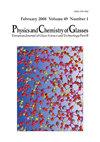Na2O取代V2O5对碱性Na2O - b2o3 - V2O5玻璃弹性性能的分析与预测
IF 0.3
4区 材料科学
Q4 CHEMISTRY, PHYSICAL
Physics and Chemistry of Glasses-European Journal of Glass Science and Technology Part B
Pub Date : 2019-12-18
DOI:10.13036/17533562.60.6.09
引用次数: 4
摘要
在这篇文章中,我们继续我们最近的工作(30,42)对碱硼钒酸盐玻璃弹性性能的预测。利用已有的理论和方法,对Na2O - b2o3 - V2O5三元碱玻璃中V2O5被Na2O取代后弹性模量和泊松比的变化进行了分析和预测。根据构成玻璃网络的基本结构单元,对每单位体积玻璃的填充密度和解离能进行了评估。此外,根据Makishima-Mackenzie模型计算了弹性模量和泊松比的理论值,并与相应的实验值进行了比较。结果表明,基本结构单元BO3、BO4、VO5和VO4的浓度对修正实验弹性模量与计算单位体积解离能之间的异常行为起主导作用。大多数样品的理论弹性模量与实验弹性模量非常吻合。在Abd El-Moneim和Alfifi的方法的基础上,还获得了体积模量与堆积密度与平均原子体积之比之间的关系。本文章由计算机程序翻译,如有差异,请以英文原文为准。
On the analysis and prediction of elastic properties in alkali Na2O–B2O3–V2O5 glasses under the substitution of V2O5 by Na2O
In this article, we have continued our recent work(30,42) on the prediction of elastic properties in alkali borovanadate glasses. Changes in the elastic moduli and Poisson’s ratio due to the substitution of V2O5 by Na2O in the ternary alkali Na2O–B2O3–V2O5 glasses have been analysed and predicted on the basis of the theories and approaches that existing in the field. Both the packing density and dissociation energy per unit volume of the glass were evaluated in terms of the basic structural units that constitute the glass network. In addition to this, the theoretical values of elastic moduli and Poisson’s ratio were calculated from the Makishima–Mackenzie’s model and compared with the corresponding experimental values. The results revealed that the concentrations of the basic structural units BO3, BO4, VO5 and VO4 play a dominant role in correcting the anomalous behaviour between experimental elastic moduli and calculated dissociation energy per unit volume. An excellent agreement between the theoretical and experimental elastic moduli was achieved for majority of the samples. The correlation between bulk modulus and the ratio between packing density and mean atomic volume has also been achieved on the basis of Abd El-Moneim and Alfifi’s approaches.
求助全文
通过发布文献求助,成功后即可免费获取论文全文。
去求助
来源期刊

CiteScore
0.70
自引率
33.30%
发文量
0
审稿时长
1 months
期刊介绍:
Physics and Chemistry of Glasses accepts papers of a more purely scientific interest concerned with glasses and their structure or properties. Thus the subject of a paper will normally determine the journal in which it will be published.
 求助内容:
求助内容: 应助结果提醒方式:
应助结果提醒方式:


